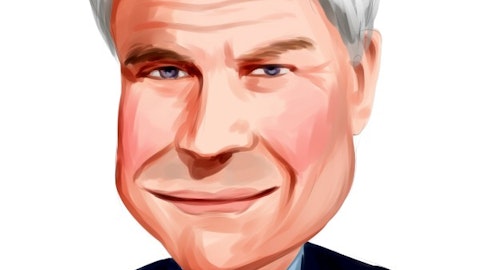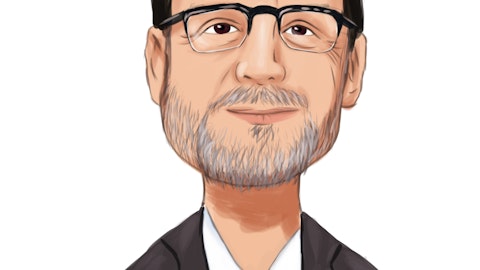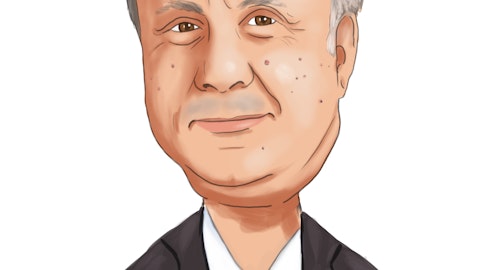First Industrial Realty Trust, Inc. (NYSE:FR) Q1 2023 Earnings Call Transcript April 20, 2023
First Industrial Realty Trust, Inc. beats earnings expectations. Reported EPS is $0.42, expectations were $0.28.
Operator Good day, and welcome to First Industrial Realty Trust’s First Quarter Results Conference Call. All participants will be in listen-only mode, [Operator Instructions]. After today’s presentation there’ll be an opportunity to ask question [Operator Instructions]. Please note, this event is being recorded.I would now like to turn the conference over to Art Harmon, Vice President of Investor Relations and Marketing. Please go ahead.Arthur Harmon Thank you, Marliese. Hello, everybody, and welcome to our call. Before we discuss our first quarter 2023 results and our updated guidance for the year, let me remind everyone that our call may include forward-looking statements as defined by federal securities laws. These statements are based on management’s expectations, plans and estimates of our prospects.Today’s statements may be time sensitive and accurate only as of today’s date, April 20, 2023.
We assume no obligation to update our statements or the other information we provide. Actual results may differ materially from our forward-looking statements and factors which could cause this are described in our 10-K and other SEC filings. You can find a reconciliation of non-GAAP financial measures discussed in today’s call in our supplemental report and our earnings release. The supplemental report, earnings release and our SEC filings are available at firstindustrial.com under the Investors tab.Our call will begin with remarks by Peter Baccile, our President and Chief Executive Officer; and Scott Musil, our Chief Financial Officer; after which we’ll open it up for your questions. Also with us today are Jojo Yap, Chief Investment Officer; Peter Schultz, Executive Vice President; Chris Schneider, Senior Vice President of Operations; and Bob Walter, Vice President of Capital Markets and Asset Management.Now let me hand the call over to Peter.Peter Baccile Thank you, Art, and thank you all for joining us today.
2023 is off to an excellent start. Our team continues its strong track record of leasing success, maintaining high occupancy, capturing increasing rents on new and renewal leasing and securing tenants for our new developments. As a result of our performance, we are raising our estimate for our 2023 cash rental rate and our full year FFO guidance.Moving now to the broader U.S. industrial market. Fundamentals continue to drive high rates of occupancy, both nationally and within our target markets. There’s a fair amount of new supply coming online this year as developers ramped up in 2022 and to capture incremental demand. However, we expect new starts to decline throughout 2023 compared to last year due to higher capital costs of constrained lending environment and lower land acquisition volumes.
Given our primary focus on land-constrained coastal markets for our new developments, we continue to feel good about the positioning of our current projects as well as our land holdings most of which are ready to go as market conditions warrant.Our portfolio performance continues to outpace the national market. We finished the first quarter with an occupancy rate of 98.7% and our cash rental rate change for leases commencing in the first quarter was 58.3%, a new quarterly record for our company. On a straight-line basis, rents were up 85% in the quarter. As of yesterday, approximately 63% of our 2023 lease expirations are in the books at a cash rental rate increase of 56%. Given our release is signed to date and our expectations for the remaining 2023 expirations, we anticipate that our increase on rental rates on new and renewal leasing will now be in the range of 45% to 55%.

STUDIO GRAND OUEST/Shutterstock.com
This new midpoint is 5 percentage points higher than the midpoint we provided on our February call.Moving on to development activity. Since our last earnings call, we signed full building leases for the 198,000 square foot First Park Miami building, 10 and the 105,000 square foot first Lehigh Logistics Centre in the Lehigh Valley market of Pennsylvania. We leased 50% of our 128,000 square foot first steel building in Seattle. We also inked a 27,000 square foot lease at our 4 building 347,000 square foot first loop logistics park in Orlando. That newly completed project is now 56% leased. Given our development leasing progress and the favourable supply-demand dynamics in its submarket, we broke ground on First State crossing in the infill Philadelphia metro market.
The site is located just 12 miles from the Philadelphia Airport with great access to both I-95 and I-495. First State Crossing will be a 358,000 square foot facility with a total estimated investment of $61 million and a projected cash yield of 6.8%.Including the first quarter development start, our developments in process totalled 3.6 million square feet with an investment of $569 million, which are currently 12% leased. The projected cash yield for these investments is 7.3%, which represents an expected overall development margin of approximately 65%. In total, our balance sheet land today can support an additional 13.8 million square feet. This represents approximately $2.1 billion of potential new investment based on today’s estimated construction costs and the land at our book basis.
These figures exclude our remaining share of the land in our Phoenix joint venture.Speaking of that venture, in the first quarter, we sold 31 acres to a data centre user for a sales price of $50 million. Our share of the gain in incentive fee before tax was approximately $24 million. In conjunction with this sale, the venture entered into an agreement with the buyer, which provides them an option to purchase an additional 71 acres, within the next two years. As part of this agreement, the buyer is required to lease the ground for up to two years, and our share of the ground lease rent is approximately $200,000 a month. As you can see, with a little over two months’ time lapse from our fourth quarter call, we’ve had some great results and activity across our entire platform.With that, I’ll turn it over to Scott for his comments.Scott Musil Thanks, Peter.
Let me recap our results for the quarter. NAREIT funds from operations were $0.59 per fully diluted share compared to $0.53 per share in 1Q 2022.Our first quarter results included income of $0.02 per share related to the accelerated recognition of a tenant improvement reimbursement associated with a departing tenant in Dallas. Excluding this $0.02 per share impact, first quarter 2023 FFO per share was $0.57. As an aside, we were successful in backfilling the Dallas space with no downtime for a gross cash rental rate increase of 54%. Our cash same-store NOI growth for the quarter, excluding termination fees, was 8.1%. The results in the quarter were driven by increases in rental rates on new and renewal leasing, rental rate bumps embedded in our leases and higher average occupancy, partially offset by higher free rent an increase in real estate taxes.
As Peter noted, we finished the quarter with in-service occupancy of 98.7%, down 10 basis points compared to year-end and up 70 basis points compared to 1Q 2022.Our tenant retention by square footage was 63%, so maintaining our high occupancy level quarter-to-quarter demonstrates the great job by our team of backfilling move-outs. Summarizing our leasing activity during the quarter, approximately 4 million square leases commenced. Of these, 1.2 million were new, 2.4 million were renewals and 300,000 were for developments and acquisitions with lease-up.Moving on to our updated 2023 guidance per our earnings release last evening. Our guidance range for NAREIT FFO is now $2.35 to $2.45 per share. Excluding the $0.02 per share income item I discussed earlier, our guidance range is $2.33 to $2.43 per share with a midpoint of $2.38.
This is a $0.04 per share increase at the midpoint primarily due to our leasing performance and our share of the monthly ground lease rent we expect to receive from our joint venture that Peter mentioned. Key assumptions for guidance are as follows: quarter end average in-service occupancy of 97.75% to 98.75%. Same-store NOI growth on a cash basis before termination fees of 7.75% to 8.75%, an increase of 25 basis points at the midpoint compared to our prior earnings call. Note that the same-store calculation excludes $1.4 million of income related to insurance claim settlements recognized in the fourth quarter of 2022. Guidance includes $0.02 per share of FFO from joint ventures, primarily related to our share of the ground rent discussed earlier.
Guidance includes the anticipated 2023 costs related to our completed and under construction developments at March 31.For the full year 2023, we expect to capitalize about $0.09 per share of interest. In our G&A expense guidance range is unchanged at $34 million to $35 million. Guidance does not reflect the impact of any future sales, acquisitions, new development starts, fees debt repurchases or repayments nor the potential issuance of equity after this call.Let me turn it back over to Peter.Peter Baccile Thanks, Scott. 2023 is off to a great start. Our portfolio results were outstanding, and the FR team continues to drive long-term cash flow growth and value creation. We’re also well positioned to take advantage of new opportunities with a strong capital base and no debt maturities until 2026, assuming extension options.
As a team, we are laser-focused on executing on our rent growth and development opportunities.Operator, with that, we’re ready to open up for questions.Arthur Harmon Marliese?
See also 25 Highest Paying Jobs in the World and Top 50 Perfume Brands in the World.
Question-and-Answer Session Operator [Operator Instructions]
And our first question comes from Ki Bin Kim from Truist. Ki please, go ahead.Ki Bin Kim Thanks, good morning. Can you guys talk about the prospect activity that you’re seeing in your development pipeline and how that might have changed over the past couple of quarters?Peter Schultz Ki, good morning, it’s Peter. Generally, activity continues to be broad-based across all of the projects and sectors. We continue to see strong demand from 3PLs, from retailers, from food and beverage, automotive, e-commerce, medical, and that has been pretty consistent, I would say, it’s gotten broader over the last several months.
In terms of our completed buildings, not yet leased in Denver, Nashville and Florida, we continue to see interest from full and partial building prospects on those assets. And I would say the activity has been pretty consistent, not better or worse than it’s been since the beginning of the year. Jojo?Johannson Yap Sure. And just to add more detail on the activity that includes responding to RFPs, request for proposals, inquiries and tours, including showings on either existing product that’s completed or other construction.Peter Baccile Overall, Ki Bin, the activity is characteristic of 2018, 2019. We mentioned on the last call, we see demand normalizing. And you’ll recall, those were very, very good years. So we’re coming off the kind of bubble created by COVID and prospect activity is pretty good.Ki Bin Kim Okay.
And you guys mentioned on the opening remarks that you do see, I guess, everyone sees it a — a decent amount of supply coming in at least in the near term, although like the future supply might be a little bit less, right, given the start volumes. But as we are trying to absorb the amount of supply coming in, how do you think about potentially throttling your development pipeline as we enter potentially a little bit of a soft patch in the economy?Peter Baccile Yes. There is significant space coming. We see in our 18 markets, and that includes the three that we’re not investing in right now, about 400 million to 450 million square feet coming this year. About 20%, 25% of that is pre-leased. So it’s not all spec. And — but we also see keep it.
So that will bump vacancies up a little bit. But we also see a pretty big slowdown in starts, probably down in the first quarter, 40% to 50% this year so far, and we think it’s going to continue to decline. And so probably towards the end of next year, you’ll see vacancies kind of come back to where they are now, maybe even a little bit lower. So the market, we think the dynamic is going to remain where it’s a landlord market. We’ll see a tick up in vacancy in the short term, but we don’t see that changing the leasing dynamic at all. And again, we’re obviously going to keep an eye on it. It will impact the health of the markets will clearly impact what and when we decide to build. You’ll note that if you look at our development pipeline, we have several projects that are ready to go, and they are primarily in California and Florida, two of the strongest markets right now in the country.Ki Bin Kim Okay, thank you.
Operator And our next question comes from Rob Stevenson from Janney. Rob, please go ahead. Robert Stevenson Fourth quarter on average was about 77% and 64% this quarter at the midpoint. Given that there’s a good deal of overlapping projects, what’s the difference there? Is that really high margins on the stuff that you completed, lower margins on the first day crossing project? Any sort of read-through on rent or construction cost pressures that you’re seeing overall? How should we be thinking about that?Peter Baccile Yes, really sorry, but the first, I don’t know, 15% of your question we didn’t hear. Can you ask it again? Robert Stevenson Sure. So Peter, you were talking about the expected profit margin and the development pipeline is sort of mid-60s on average.
It was high 70s last quarter. Given that there’s a bunch of overlapping projects between fourth quarter and first quarter here, what’s the difference there? Is that high margins on the stuff that you just completed, lower margins on the Philly project? Is it read through on rent or construction cost pressures? How are you sort of framing that? And how should we be thinking about that?Peter Baccile I’ll take a crack at that and Jojo can jump in. That 65% relates to Philly, not the whole development pipeline. We have just to note that we have adjusted our assumption on cap rates. In the last quarter, we bumped it up 25 basis points. So if you go back to this time last year, when we first started talking about cap rates, we have increased our cap rate assumption for our margin calculations a little bit over 125 basis points.
So that will obviously have an impact on the margins that we’re talking about today.Johannson Yap Yes. So that is the primary reason for the movement in the profit margins. It’s roughly a 25 basis point increase from Q4 cap rate wise from Q4 2022 to date. As there were slight tweaks, Rob, in terms of — of course, we keep all the construction cost accurate but that were so slight and there was no movement in rents really. And so the major contributor to that difference in margin is the self-imposed cap rate increase for the [indiscernible].Robert Stevenson And are you seeing any real relief in construction and material or labor cost on the construction side these days? Or is still relatively where it’s been over the last few quarters?Johannson Yap Okay.
Good question. The total construction cost actually are flat to a slight decrease when you compare Q4 to Q1 2022, steel prices actually came down, but there were some components that also came up. Concrete, electrical and dock doors came up a little bit. We think it’s going to moderate. We already see the moderation. But for 2023, our internal underwriting criteria will use a 5% cost escalation. We think there is some downside trended that depending upon the number of construction starts. Because if construction starts continue to be at a low level, we should feel a little bit more moderate increase. Does that answer your question?Robert Stevenson Absolutely. That’s great. Thank you. And then, Scott, what are you seeing today in terms of availability and pricing on debt financing?
What is your best cost of debt?Scott Musil I would break it into two pieces. One, I would look at the bank loan — term loan market. And as everyone knows, we closed on the $300 million term loan in August of last year. That market has changed quite a bit. Our maturity was a five-year deal. And I would say what you’re seeing in the market, if you have strong relationships with the banks is probably two to three years of term. The pricing grid has not changed, but the upfront fees have increased considerably. So, August compared to where we’re at today at the bank term loan market, maturities aren’t as long, and the total costs, including fees is up. I would say the other option that we have is doing a public bond deal or a private placement.




